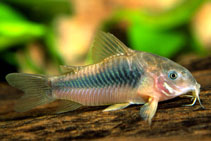| Family: |
Callichthyidae (Callichthyid armored catfishes), subfamily: Corydoradinae |
| Max. size: |
7.5 cm SL (male/unsexed) |
| Environment: |
demersal; freshwater; pH range: 6 - 8; dH range: 5 - 19 |
| Distribution: |
South America: Colombia and Trinidad to La Plata River basin east of the Andes. |
| Diagnosis: |
Dorsal spines (total): 1-1; Dorsal soft rays (total): 7-7; Anal spines: 1-2; Anal soft rays: 5-6. Short and rounded snout (1.9 to 2.1 times in TL); body height 2.5 to 2.9 times in SL; interorbital space 2 to 2.2 times in TL; pectoral spine (3.5 to 4.5 times in SL) with a slightly denticulated internal side; 23-24 dorsal plates; 20-22 ventral plates; 2-5 pre-adipose plates; body color yellow or pink, white belly, blue-grey over head and back; fins yellow or pink and immaculate (Ref. 35381). A brownish-orange patch is usually present on the head, just before the dorsal fin, and is their most distinctive feature when viewed from above in the stream (Ref. 44091). |
| Biology: |
Found mostly in quiet, shallow waters with soft bottoms (Ref. 26041), but also inhabits running waters (Ref. 11225). Benthic (Ref. 58302). Stays in schools of 20 to 30 individuals. Because of its ability to breathe air intestinally, it takes air 1 to 45 times per hour (Ref. 35381). Nocturnal (Ref. 35381). Feeds on worms, crustaceans, insects and plant matter (Ref. 7020). Spawning occurs when the physical-chemical quality of the water changes with the onset of the rainy season (Ref. 35381). Aquarium keeping: in groups of 5 or more individuals; minimum aquarium size 60 cm (Ref. 51539). |
| IUCN Red List Status: |
Least Concern (LC); Date assessed: 07 November 2018 Ref. (130435)
|
| Threat to humans: |
harmless |
| Country info: |
|
Source and more info: www.fishbase.org. For personal, classroom, and other internal use only. Not for publication.

